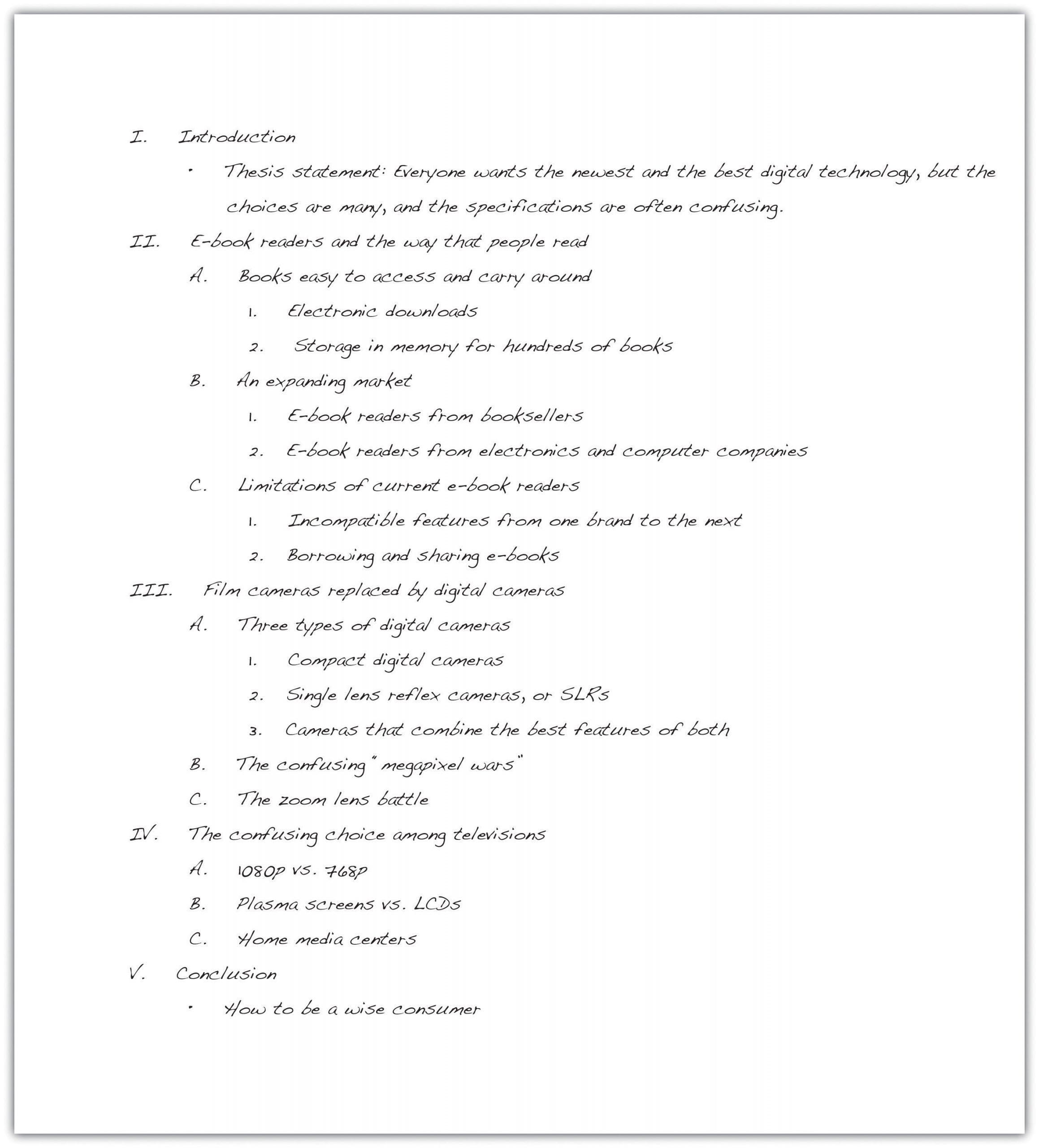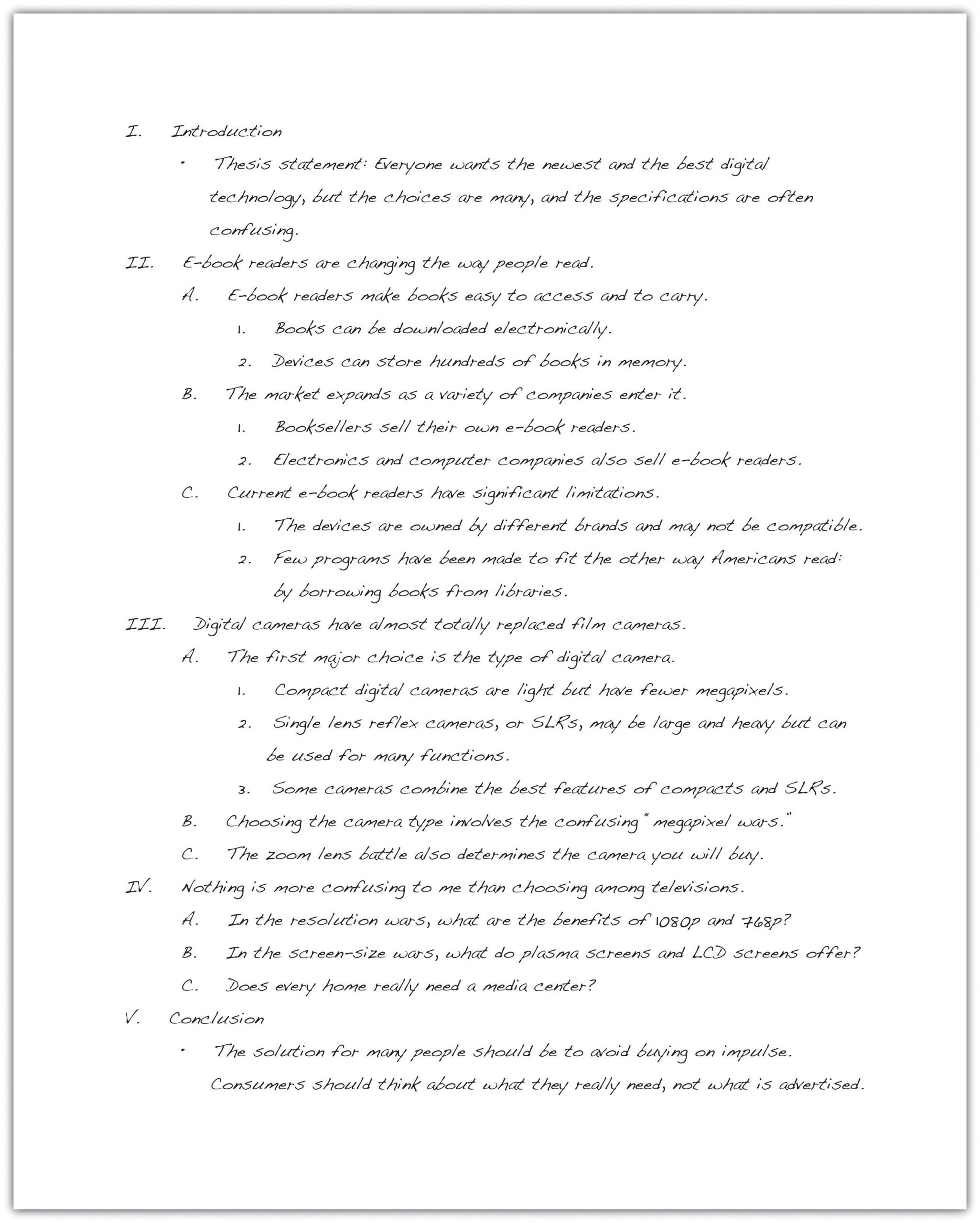Outlining
Your prewriting activities and readings have helped you gather information for your assignment. The more you sort through the pieces of information you found, the more you will begin to see the connections between them. Patterns and gaps may begin to stand out. But only when you start to organize your ideas will you be able to translate your raw insights into a form that will communicate meaning to your audience.
Organizing Ideas
When you write, you need to organize your ideas in an order that makes sense. The writing you complete in all your courses exposes how analytically and critically your mind works. In some courses, the only direct contact you may have with your instructor is through the assignments you write for the course. You can make a good impression by spending time ordering your ideas.
Order refers to your choice of what to present first, second, third, and so on in your writing. You will of course let the subject of your essay guide the order you use (ex: a historical subject is likely to benefit from chronological order), but you will also want to let your purpose and audience guide your decisions.
The three common methods of organizing writing are chronological order, spatial order, and order of importance. See more about these in the section Organizing Body Paragraphs.
Writing an Outline
Outlines are the most common form of organization. Many college instructors require students to submit a formal outline before writing a major essay as a way to be sure you are on the right track and are working in an organized manner. A formal outline is a detailed guide that shows how all your supporting ideas relate to each other. It helps you distinguish between ideas that are of equal importance and ones that are of lesser importance. You build your paper based on the framework created by the outline.
There are two types of formal outlines: the topic outline and the sentence outline. You format both types of formal outlines in the same way.
- Place your introduction and thesis statement at the beginning, under Roman numeral I.
- Use Roman numerals (II, III, IV, V, etc.) to identify main points that develop the thesis statement.
- Use capital letters (A, B, C, D, etc.) to divide your main points into parts.
- Use Arabic numerals (1, 2, 3, 4, 5, etc.) if you need to subdivide any As, Bs, or Cs into smaller parts.
- End with the final Roman numeral expressing your idea for your conclusion.
Here is what the skeleton of a traditional formal outline looks like. The indention helps clarify how the ideas are related.
-
Introduction
Thesis statement
-
Main point 1 → becomes the topic sentence of body paragraph 1
1. Supporting detail → becomes a support sentence of body paragraph 1
2. Supporting detail
3. Supporting detail
-
-
Main point 2 → becomes the topic sentence of body paragraph 2
-
-
Main point 3 → becomes the topic sentence of body paragraph 3
-
- Conclusion
Tip
In an outline, any supporting detail can be developed with subpoints. For simplicity, the model shows them only under the first main point.
Tip
Formal outlines are often quite rigid in their organization. As many instructors will specify, you cannot subdivide one point if it is only one part. For example, for every Roman numeral I, there must be a For every A, there must be a B. For every Arabic numeral 1, there must be a 2. See for yourself on the sample outlines that follow.
Example of Constructing Topic Outlines
A topic outline is the same as a sentence outline except you use words or phrases instead of complete sentences. Words and phrases keep the outline short and easier to comprehend. All the headings, however, must be written in parallel structure. (For more information, see the section Parallelism.)
Here is the topic outline that Mariah constructed for the essay she is developing. Her purpose is to inform, and her audience is a general audience of her fellow college students. Notice how Mariah begins with her thesis statement. She then arranges her main points and supporting details in outline form using short phrases in parallel grammatical structure.

Checklist
Writing an Effective Topic Outline
This checklist can help you write an effective topic outline for your assignment. It will also help you discover where you may need to do additional reading or prewriting.
- Do I have a controlling idea that guides the development of the entire piece of writing?
- Do I have three or more main points that I want to make in this piece of writing? Does each main point connect to my controlling idea?
- Is my outline in the best order—chronological order, spatial order, or order of importance—for me to present my main points? Will this order help me get my main point across?
- Do I have supporting details that will help me inform, explain, or prove my main points?
- Do I need to add more support? If so, where?
- Do I need to make any adjustments in my working thesis statement before I consider it the final version?
Exercise 1
Using the working thesis statement you wrote above, construct a topic outline for your essay. Be sure to observe correct outline form, including correct indentations and the use of Roman and Arabic numerals and capital letters.
Example of Constructing Sentence Outlines
A sentence outline is the same as a topic outline except you use complete sentences instead of words or phrases. Complete sentences create clarity and can advance you one step closer to a draft in the writing process.
Here is the sentence outline that Mariah constructed for the essay she is developing.

Tip
The information compiled under each Roman numeral will become a paragraph in your final paper. In the previous example, the outline follows the standard five-paragraph essay arrangement, but longer essays will require more paragraphs and thus more Roman numerals. If you think that a paragraph might become too long or stringy, add an additional paragraph to your outline, renumbering the main points appropriately.
Exercise 2
Expand the topic outline you prepared above to make it a sentence outline. In this outline, be sure to include multiple supporting points for your topic sentences even if your topic outline does not contain them. Be sure to observe correct outline form, including correct indentations and the use of Roman and Arabic numerals and capital letters.
